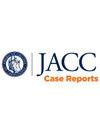Hypereosinophilic Syndrome Presenting as Coronary Artery Spasm and ST-Segment Elevation Myocardial Infarction
Q4 Medicine
引用次数: 0
Abstract
Background
Hypereosinophilic syndrome (HES) is characterized by high absolute eosinophil count and multiorgan damage. Energy drink consumption (EDC) is associated with adverse cardiovascular events, including coronary artery spasm (CAS).
Case Summary
A 31-year-old man with asthma and excessive EDC presented with chest pain, hypotension, and inferior ST-segment elevation myocardial infarction with elevated troponin to 1,081 ng/L. Given persistent CAS refractory to coronary vasodilators, he underwent balloon angioplasty of the right coronary artery and first diagonal branch. Despite initial improvement, his absolute eosinophil count and systemic symptoms worsened. Gastrointestinal, pulmonary, and bone marrow biopsies demonstrated eosinophilic infiltration. He achieved remission with corticosteroids.
Discussion
ST-segment elevation myocardial infarction from CAS is a rare cardiac manifestation of HES. The multidisciplinary management requires pharmacologic and interventional therapies to reduce inflammation and prevent cardiovascular sequelae.
Take-Home Message
This case highlights the importance of early recognition and treatment HES in patients with unexplained myocardial infarction, particularly when associated with EDC and the absence of atherosclerotic risk factors.
高嗜酸性粒细胞综合征表现为冠状动脉痉挛和st段抬高型心肌梗死
背景:高嗜酸性粒细胞综合征(HES)以嗜酸性粒细胞绝对计数高和多器官损伤为特征。能量饮料消费(EDC)与不良心血管事件有关,包括冠状动脉痉挛(CAS)。病例总结:31岁男性哮喘伴过度EDC,表现为胸痛、低血压、下st段抬高型心肌梗死,肌钙蛋白升高至1081 ng/L。由于持续的CAS对冠状动脉血管扩张剂难治,他接受了右冠状动脉和第一斜支球囊血管成形术。尽管最初有所改善,但他的绝对嗜酸性粒细胞计数和全身症状恶化。胃肠道、肺和骨髓活检显示嗜酸性粒细胞浸润。他使用皮质类固醇后病情得到缓解。CAS st段抬高型心肌梗死是HES罕见的心脏表现。多学科的管理需要药物和介入治疗,以减少炎症和预防心血管后遗症。该病例强调了早期识别和治疗不明原因心肌梗死患者HES的重要性,特别是当伴有EDC和没有动脉粥样硬化危险因素时。
本文章由计算机程序翻译,如有差异,请以英文原文为准。
求助全文
约1分钟内获得全文
求助全文
来源期刊

JACC. Case reports
Medicine-Cardiology and Cardiovascular Medicine
CiteScore
1.30
自引率
0.00%
发文量
404
审稿时长
17 weeks
 求助内容:
求助内容: 应助结果提醒方式:
应助结果提醒方式:


